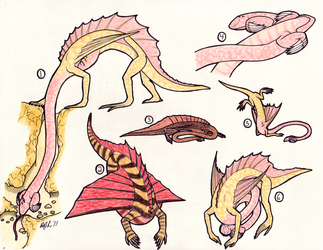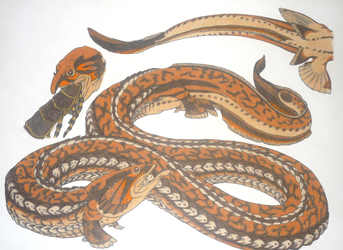Sign In
CloseConseco Dentata "Dismembering Teeth"
A mammalian xenomorph, this species is a top predator on its planet, the adults rarely falling prey to its competition. Living and hunting in packs, the conseco dentata has an advantage over the other predators. Not only is it intelligent enough to form social groups, giving it safety in numbers, but it can work together to bring down much larger prey than itself. The females generally stand 18' tall and 16' long, with males nearly doubling that at 33' and 29' long. Due to the low density and high oxygen content of its planet, it weighs much less than it appears to. Were a specimen to be brought to Earth or a planet with similar atmospheric properties, it would collapse beneath its own weight and suffocate, its body not built for our gravity or our air.
Its round, stubby body is held above the ground by its two long, slender front legs. It's two toed front feet are tipped in upturned claws that it can use to defend itself, the edges staying sharp due to being held up off the ground. It's shorter, flattened back feet are used as a counterbalance for its heavy head, and also a rudder while running. It's two back toes have small vestigial nails. Both its elbows and heels have fins of cartilage; its use on its front legs is unknown, but it uses the ones on its back legs to help it steer.
It's head has a single large nostril that has three passages, two of which are used to direct airflow throughout the body, while the third filters any water that may enter the nostril, causing it to be partially amphibious as the water is used to further provide its body with oxygen. It exhales by means of two tubes on its rump, which also expels the deoxygenated water, creating a spout not unlike a whale does when exhaling. Its eyes are forward facing and in place of an eyelid it has a nictitating membrane, which not only acts as a mini-windshield wiper or goggles to keep its eyes dry, but also is tinted a light teal to better allow it to see when the red giant sun is highest in the sky and giving everything a red hue; the membrane causes it to see everything in a green hue instead. They don't appear to have any external ears, but do communicate with sounds, so it is possible that their ears are beneath a thin layer of skin somewhere on their body that picks up sound. Its strange mouth looks to be a beak, but has a single row of teeth in the middle of the beak on both the upper and lower jaws. Along the upper beak is a hollow tube that goes from a sac in its cheeks to just near the end of the beaks tip. This expels a mucus which it uses while hunting. Inside its mouth are two tongues that are normally withdrawn into its throat pouch, but which can be extended, and have spade-shaped ends which are covered with tiny sharp protrusions not unlike a lions tongue has which can strip flesh from bone.
Packs are generally made up of one or two males (always brothers if the latter is the case) and three to eight females. They communicate through loud screeches and trills, as well as signaling with their hind legs and clapping the limbs together. When hunting, the male(s) will rush at the targeted herd, scattering the prey. The females then go after what looks like the easiest target and separates it from the rest of the herd. The whole pack then closes in and nips at the legs of the prey, a thick mucus blown through their beak tubes into the wounds. Once the pack deems the prey sufficiently injured, they let it rejoin the herd. The prey is too large for them to take down without being injured badly or killed, so they have evolved to let the voracious bacteria in their mucus do it for them. The pack will stalk the herd over the next few days while the targeted prey grows steadily sicker, waiting for it to collapse. Once left behind by the herd, the pack will close in and begin using their saw-like teeth to rip large chunks off of the still alive prey, earning them their name, "dismembering teeth". They use their tongues to scrape off smaller pieces and push them down their throat. A single kill can feed a pack for a few weeks, so long as they can protect their kill. It's not uncommon for them to feed on the scavengers that are attracted to the large corpse either. Males without females will hunt in packs of two's and three's with other single males. During wild fires, packs can be found before the fires, picking off smaller fleeing animals, and behind them, scavenging on the burned corpses.
During mating season, the males stand with their back legs stretched back and clap them together loudly. This alerts all juvenile males in the vicinity that they can challenge the pack leader. The males will face each other and clap their back legs together while stamping their front feet and screeching at each other. The less impressive male will back down and the next challenger will approach. The winner gets to mate with all the females in the pack. The males don't always play fair though, and some will trick the females into following them while the dominant male is competing with the other males. However a male succeeds in winning over the females, once he has, mating will commence.
Males store their genitalia in a pouch, while females have a prehensile ovipositor which they normally keep hidden inside their bodies. Females will place their ovipositors in the males pouch to be fertilized. Two months later the females will give birth to one or two tiny young which they lay within the males pouch. The much larger male can have as many as twelve young in his pouch, though generally only one to three survive. The young will stay in the pouch for a year, feeding off of the males specialized sweat glands within the pouch, which secrete nutrients, as well as the males feces which contains partially digested food due to the males digestion system altering during his time as a parent. Males generally do not help hunt while rearing young due to being bottom heavy and thus not being efficient at running, let alone hunting. The females become very aggressive during the time the young are being raised, and are quick to attack any perceived threats. The females seem to enjoy feeding the young chunks of food, whether it's their offspring or not. After the young are half their mothers size, they will be forced to leave the pouch for good and will tag along with the pack for another six months to teach them how to act before they'll be chased off to either start or join another pack.
While conseco dentata has few natural predators, it is not without protection. Its fellow pack members is its biggest advantage, as despite not being very large in comparison to other predators on its planet, it has strength in numbers. It can also spray mucus at a high velocity, which it aims rather accurately at eyes and noses, leaving the would-be predator confused and giving it a chance to flee. If enough of the mucus gets into the bloodstream, the would-be predator can become food for its would-be prey.
Image and Conseco Dentata (c) Scott Francis
Submission Information
- Views:
- 392
- Comments:
- 0
- Favorites:
- 2
- Rating:
- General
- Category:
- Visual / Traditional




